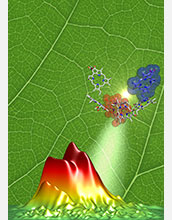Multimedia Gallery
Peering into the mechanics of photosynthesis (Image 2)
In this image, sunlight illuminates the photosystem II reaction center, initiating the primary events of oxygenic photosynthesis on an ultrafast timescale. Located in the chloroplasts of plant cells, photosystem II is the group of proteins and pigments that does the photosynthetic heavy lifting. It's also the only known natural enzyme that uses solar energy to split water into hydrogen and oxygen. In the background is a redbud tree leaf from Ann Arbor, Mich., where multidimensional spectroscopy experiments have revealed key vibrational motions driving photosynthetic charge separation. In the foreground are recorded spectroscopic signatures identifying key vibrations.
"This particular system is of great interest to people because the charge separation process happens extremely efficiently," said Jennifer Ogilvie, an associate professor of physics and biophysics at the University of Michigan (U-M) and lead author of a paper on this research. "In artificial materials, we have lots of great light absorbers and systems that can create charge separation, but it's hard to maintain that separation long enough to extract it to do useful work. In the photosystem II reaction center, that problem is nicely solved."
Ogilvie and U-M colleagues used short pulses of light to peer into the mechanics of photosynthesis--the process by which plants and some bacteria turn sunlight, water and carbon dioxide into food for themselves and oxygen for animals to breathe--and illuminate the role that molecule vibrations play in the energy conversion process that powers life on Earth.
The U-M researchers identified specific molecular vibrations that help enable charge separation--the process of kicking electrons free from atoms in the initial steps of photosynthesis that ultimately converts solar energy into chemical energy for plants to grow and thrive. It takes about one-third of a second to blink your eye. Charge separation happens in roughly one-hundredth of a billionth of that amount of time.
Ogilvie and her research group developed an ultrafast laser pulse experiment that can match the speed of these reactions. By using carefully timed sequences of ultrashort laser pulses, the researchers were able to initiate photosynthesis and then take snapshots of the process in real time.
Findings from this research--supported in part by the National Science Foundation (CAREER award PHY 07-48470)--could potentially help engineers make more efficient solar cells and energy storage systems.
To learn more, see the U-M news story Deep within spinach leaves, vibrations enhance efficiency of photosynthesis. (Date of Image: May 2014) [Image 2 of 2 related images. See Image 1.]
Credit: Vytautas Butkus, Vilnius University; Jennifer Ogilvie, University of Michigan
Images and other media in the National Science Foundation Multimedia Gallery are available for use in print and electronic material by NSF employees, members of the media, university staff, teachers and the general public. All media in the gallery are intended for personal, educational and nonprofit/non-commercial use only.
Images credited to the National Science Foundation, a federal agency, are in the public domain. The images were created by employees of the United States Government as part of their official duties or prepared by contractors as "works for hire" for NSF. You may freely use NSF-credited images and, at your discretion, credit NSF with a "Courtesy: National Science Foundation" notation.
Additional information about general usage can be found in Conditions.
Also Available:
Download the high-resolution TIF version of the image. (45.3 MB)
Use your mouse to right-click (Mac users may need to Ctrl-click) the link above and choose the option that will save the file or target to your computer.

